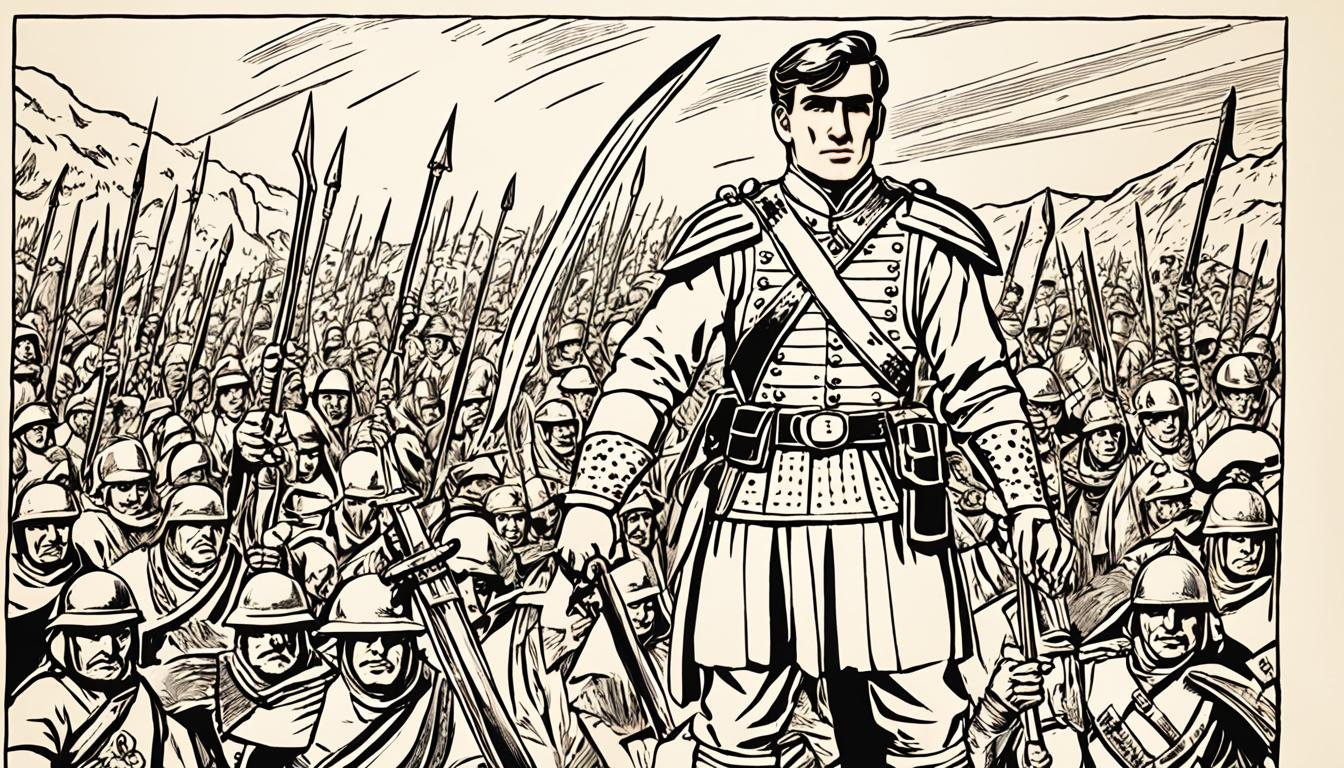During the Spanish Colonial Period in the Philippines, the Gwardiya Sibil was essential for keeping peace. They used a particular weapon as their standard. This weapon was crucial for the agency’s tasks at that time.
The history of the Gwardiya Sibil’s standard weapon is full of importance. It marked an influential period in the country. Let’s explore its past and the impact it had during those years.
Key Takeaways:
- The Gwardiya Sibil was an essential law enforcement agency in the Spanish Colonial Period in the Philippines.
- They were equipped with a standard weapon that played a crucial role in maintaining peace and order.
- We will investigate the historical context, evolution, and cultural significance of the Gwardiya Sibil’s standard weapon.
- The arms acquisition and military strategy of the Gwardiya Sibil during the colonial period will also be discussed.
- Stay tuned to learn more about the fascinating history of the Gwardiya Sibil and its standard weapon in the Philippines.
Now, let’s look closer at how and why the Gwardiya Sibil was formed in Spanish Colonial Philippines. Click here to learn more about the Gwardiya Sibil.
Introduction to Gwardiya Sibil and its Role in Spanish Colonial Philippines
The Gwardiya Sibil was key to keeping peace during the Spanish Colonial Period in the Philippines. It was the main agency for enforcing laws to ensure the country’s stability.
The agency began in 1868, taking after the Spanish Civil Guard. Its main tasks were applying Spanish laws, keeping order, and protecting the Spanish government’s interests.
Operating across the Philippines, the Gwardiya Sibil was a clear sign of Spanish power. It was part of Spain’s strategy to maintain control and stop uprisings.
The Gwardiya Sibil had many roles, from keeping the peace to fighting crime. They made sure people followed Spanish laws and stayed loyal to Spanish authority. Their work helped prevent revolts.
The agency was deeply involved in the Philippines’ social and political life. By keeping the peace, they enforced Spain’s control over the local people. This way, they supported Spain’s rule and its strong presence.
Historical Context of the Philippine Revolution
The Philippine Revolution was a key moment in the country’s past, ending Spanish rule. It’s crucial to look back at what happened, understanding the drive for liberty.
By the late 1800s, Spain controlled the Philippines for almost 300 years. This time saw big changes, affecting the lives of Filipinos.
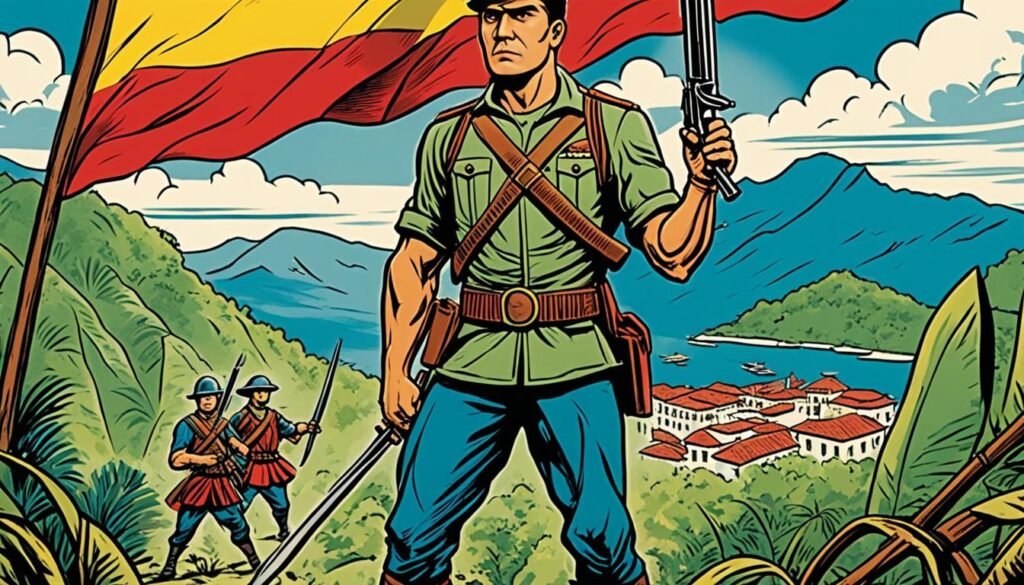
The Spanish rulers enforced unfair systems, benefiting themselves and hurting the Filipinos. They made the locals work hard, pay big taxes, and limited their schooling and human rights.
“The Philippines is essentially governed by theocracy. The friars, for example, can be said to rule the islands. Practically all civil and public business is in their name, and through them everything is done.” – Dr. Jose Rizal
The flame for the revolution lit when Filipinos stood up for their nation and their right to choose. Figures like Jose Rizal, Marcelo H. del Pilar, and Andres Bonifacio were leaders. They fought for freedom and fairness.
Their fight was not just about pure independence but also for a more just society and economy. Their sorrow and struggle under Spanish rule led them to push against it.
This was the setting for the Philippine Revolution. Filipinos came together, resolving to win their liberty and set up their own system. The revolution stands for their bravery, strength, and spirit against tough times.
The following part will go deep into the weapons used in this fight, focusing on the Spanish M93 weapon and its role during the Spanish occupation.
Infantry Armaments: A Closer Look at the Spanish M93 Standard Weapon
During the Spanish Colonial Period in the Philippines, the Gwardiya Sibil used many infantry weapons. Among these, the Spanish M93 standard weapon was a key one. It helped keep peace and order across the land.
The Spanish M93 was a bolt-action rifle. It had a five-round magazine and bullets that were 7x57mm. Its design was sleek, with a wooden stock and a metal barrel. Known for being reliable and accurate, it was a top choice for the Gwardiya Sibil.
Due to its practical use and success in battles, the Gwardiya Sibil widely adopted the Spanish M93. Its strong build let soldiers shoot continuously without losing accuracy. This made it perfect for keeping the peace during the Spanish Colonial Period.
Its power and range were beneficial in war, helping the Gwardiya Sibil beat their enemies. Due to its effectiveness, it became a symbol of security and authority at the time.
For more information on the weapons used in the Spanish Colonial Period, check out this in-depth article. It will give you a deep dive into what the Gwardiya Sibil used.
Rifles to Revolvers: The Evolution of Gwardiya Sibil Firepower
The Gwardiya Sibil, a law enforcement group in the Philippines under Spanish rule, notably changed its weapons. They upgraded from muskets to Mausers and started using revolvers. This change drastically improved how the Gwardiya Sibil fought and kept peace.
The Shift from Muskets to Mausers
Before Mauser rifles, Gwardiya Sibil used muskets. Muskets were big, had short range, and took time to reload. But, as firearm tech got better, they switched to Mausers. These had more accuracy, power, and were more effective in battles.
The Gwardiya Sibil favored Mausers, especially the Mauser Model 1893. Its bolt-action made reloading faster and shots more precise. Switching to Mausers was a big win for the Gwardiya Sibil. It gave them an upper hand in keeping the peace in the Philippines.
Handguns and Their Influence in Close-Quarter Combat
Besides long guns, Gwardiya Sibil saw the need for handguns in close combat. Revolvers were added. They were small, easy to hide, and good for close fighting.
Adding revolvers meant officers could move quick and be ready fast in tight spots. These guns were a reliable second option. They made sure officers were prepared for any trouble, helping keep the peace in the Philippines.
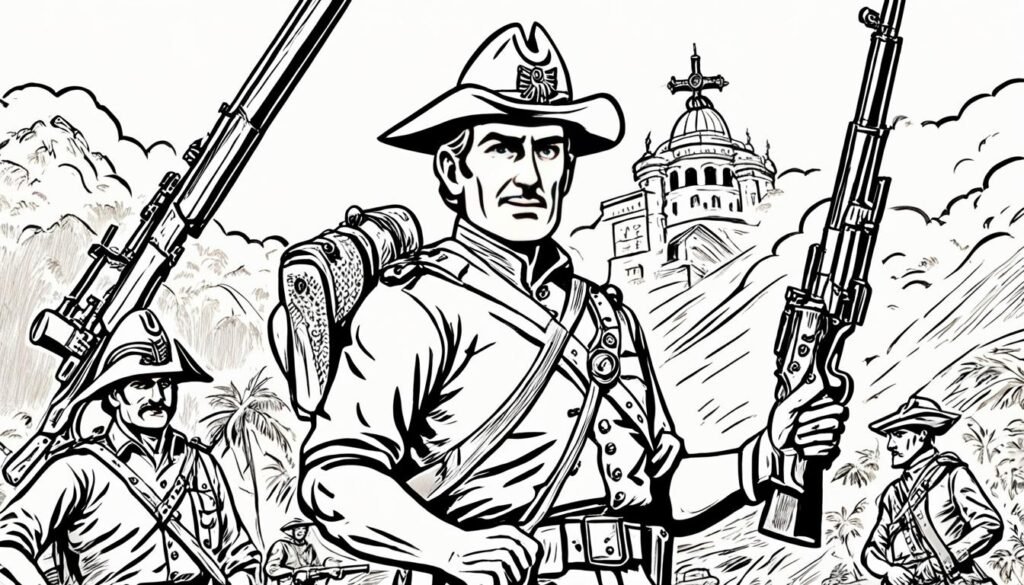
The move from muskets to Mausers and to revolvers was a big step for the Gwardiya Sibil. It shows they were serious about protecting the Filipino people in the Spanish Colonial Period. Their commitment to better arms proved their dedication to their duty.
Sources: Philstar.com
Bladed Weapons: Sabers and Bolos in the Spanish Era
In the Spanish Era, bladed weapons like sabers and bolos had a big role in the Philippines. They were key for the Gwardiya Sibil, the law keepers of that time. We’ll look at how European swords were like and how they differed from the Filipino blades. Also, we’ll dive into what these weapons meant to their cultures.
European Swords versus Filipino Crafted Blades
European swords, brought by the Spanish, were top picks for their troops and officers. They were usually steel and had fancy designs, showing off great skills. These swords were really tough and did well in fights. However, Filipino crafted blades, including the bolo, showed off local talent. They were made from materials like wood, bone, and iron. This showed the deep roots of Filipino culture.
Filipino bolos were made to fit local needs and ways of fighting. They had many uses, from self-defense to farm work. The bolo’s unique shape made it good for fighting up close. Its long, curved blade and comfy handle were just right for this.
The Cultural Significance of Melee Weapons
Bladed weapons are very meaningful in the Philippines. They stand for war tools but also for tradition, honor, and courage. Filipino fighters used their blades with great skill and the spirit of protecting their homeland from outsiders.
Blades like sabers and bolos were more than just tools. They show the Filipino spirit of strength and the will to fight. They are now a key part of Filipino culture, seen in festivals, dances, and even martial arts.
If you want more on the blades from the Spanish Era in the Philippines, check out the List of Weapons of the Philippine Revolution. You’ll find a lot about different blades and how they fit into history there.
| Bladed Weapons | Cultural Significance |
|---|---|
| Sabers | Symbol of authority and military prowess |
| Bolos | Representation of Filipino craftsmanship and close-quarters combat skills |
| Other Filipino Crafted Blades | Reflection of local culture and traditional practices |
Artillery and Machine Guns: Changing the Dynamics of Warfare
The introduction of artillery and machine guns completely changed warfare during Spain’s rule in the Philippines. These new weapons shaped how battles happened and who won them.
Artillery, including cannons and mortars, was a game changer. Its power let armies attack from far away. This let them hit enemy defenses hard, creating chaos.
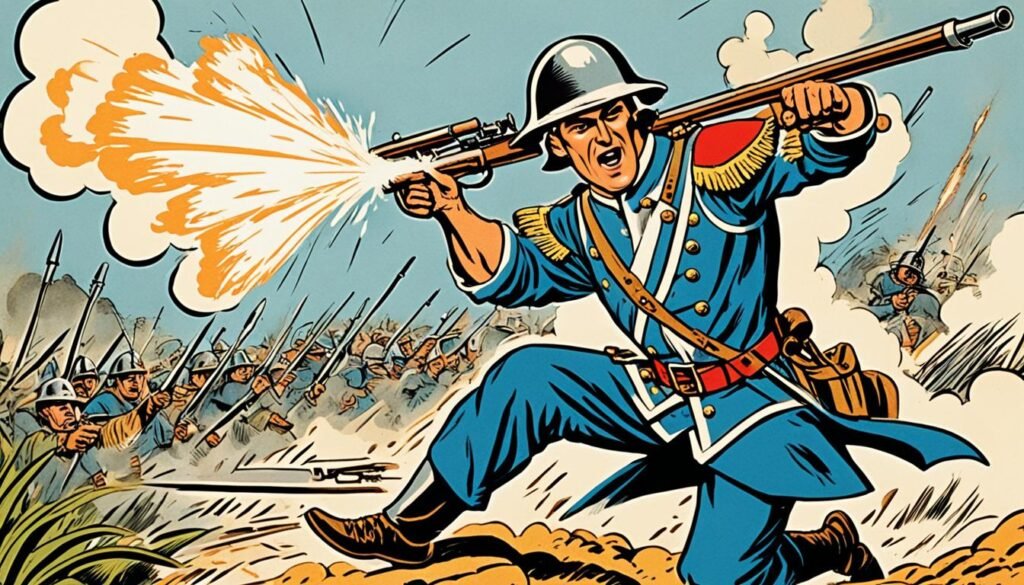
Machine guns, though, brought something new. They could shoot a lot of bullets quickly. This stopped enemy troops from moving forward easily. Machine guns made war more about quick, powerful attacks and defenses.
The Gwardiya Sibil realized how important these new weapons were. They started using them to improve their strength. This helped them win more battles and protect their land better.
Using these weapons, the Gwardiya Sibil outdid their enemies. They could fight from a distance and stop troops from advancing. This made their enemies weaker and their own land safer.
With artillery and machine guns, war tactics had to change. The Gwardiya Sibil started to use these new tools smartly. They tailored their fighting methods to take full advantage of these powerful devices.
The effects of these weapons were deep. They changed how wars were fought and won. This shaped the future of warfare strategies and technology.
Learn more about the historical significance of artillery in medieval Europe
| Weapons | Advantages | Impact |
|---|---|---|
| Artillery | – Long-range attacks | – Demolition of enemy fortifications |
| Machine guns | – Rapid and sustained firepower | – Suppression of enemy troops |
Uniforms, Insignia, and Military Regalia of the Guardia Civil
The Guardia Civil wore unique outfits during the Spanish Colonial Period in the Philippines. Their uniforms, insignia, and gear showed their importance and commitment. This made them stand out and symbolized their serious work.
Understanding the Distinctive Attire of the Gwardiya Sibil
The Guardia Civil designed their uniforms with great care. These included dark blue coats, stylish trousers, and broad hats. Such attire was not only useful but also represented their strong discipline and professionalism.
Their clothing had signs showing their ranks. The more important an officer was, the fancier their symbol. These symbols were on their hats and sleeves, showing their position with the Guardia Civil.
Each outfit of the Guardia Civil also had special shoulder boards. These boards carried the Guardia Civil’s badge. This not only showed who they were but also their unity and team spirit.
Decorations and Medals as Symbols of Valor and Honor
The Guardia Civil received badges and medals for their brave and honorable acts. These awards encouraged them to do even better in their jobs.
The medals were detailed and unique. They showed off different achievements or acts of bravery. Having one was a source of pride. These medals proved that the Guardia Civil were deeply dedicated to protecting and serving the people.
| Medal | Description |
|---|---|
| Medal of Valor | Awarded for acts of exceptional bravery and heroism in the line of duty. |
| Distinguished Service Medal | Given to members who have shown outstanding dedication and merit in their service to the Gwardiya Sibil. |
| Long Service Medal | Awarded to individuals who have served with distinction and loyalty for a significant period of time. |
| Good Conduct Medal | Presented to those who have demonstrated exemplary conduct throughout their career. |
Wearing these medals was a way for the Guardia Civil to show their promise to the law. It also remembered their hardest times and inspiring others to bravery, hard work, and integrity.
Learn more about the uniforms and regalia of the Gwardiya Sibil here.
Arms Acquisition and Military Strategy During the Colonial Period
During the Colonial Period, Gwardiya Sibil’s arms collection and war plans were shaped by many things. These included help from other countries, ideas from locals, and how different nations got along. It was key for them to get cutting-edge weapons. This helped keep control and make sure the Spanish way was followed in the Philippines.
Help from other countries was big. When the Spanish got power in the Philippines, they brought new guns and fighting methods with them. They taught the Gwardiya Sibil these tactics and gave them weapons like the Spanish M93 gun and swords from Europe. The Gwardiya Sibil mixed these with their own tactics. This made them strong against challenges and let them keep control.
The Gwardiya Sibil didn’t just copy the foreign weapons. They started mixing local skills with the making of swords and machetes. This made a cool mix of European and Filipino styles. Doing this helped those weapons work better. It also showed off the heritage of the Philippines.
In the Colonial Period, making friends worldwide was vital for getting weapons. Since the Philippines was under Spanish rule, it mainly got arms through trading and talking to other countries. This sharing and trading made the Gwardiya Sibil stronger. They could keep up with how wars were changing over time.
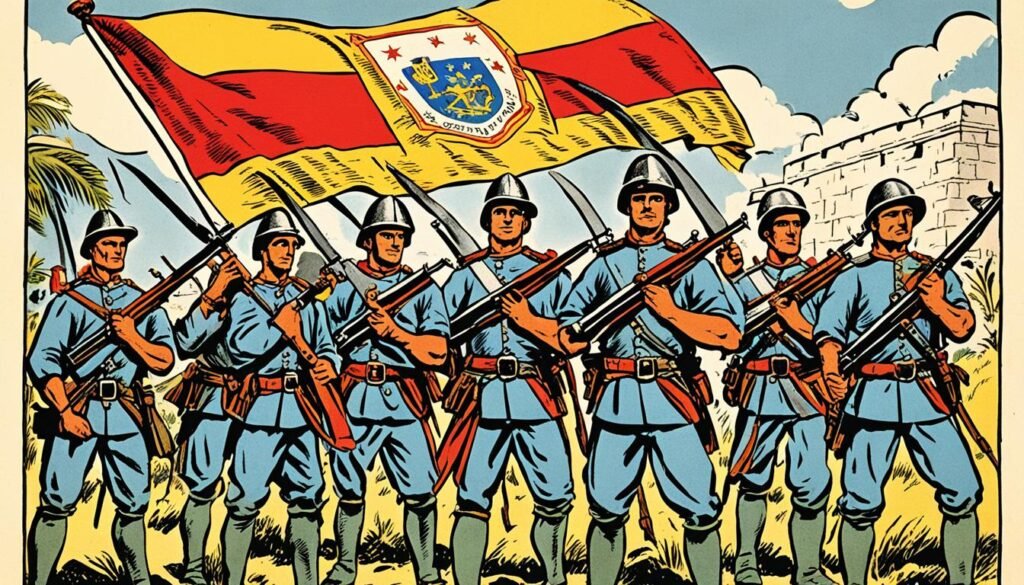
Arms acquisition and how the Gwardiya Sibil planned their fights were deeply shaped by outside help, mixing local and foreign ideas, and dealing with other countries. These things played a big part in picking what weapons to use and how to use them. It was all to keep Spanish power in the Philippines.
For more about how arms were controlled in the Colonial Period, check out the Small Arms Survey website.
Conclusion
In conclusion, during the Spanish Colonial Period in the Philippines, the Gwardiya Sibil and its weapon were key to keeping peace. This article showed how the Gwardiya Sibil was vital in making sure the country was safe and orderly.
The Gwardiya Sibil used many weapons to do its job well. They used rifles and revolvers, along with traditional weapons like sabers and bolos. These weapons helped them face various challenges effectively.
Their weapons and how they fought were influenced by others and the local needs. This mix helped them keep up with the best military practices globally and serve the Philippines well during this era.
For a detailed look at the Gwardiya Sibil and its weapon’s role, check Medscape. This source will reveal more about how the Gwardiya Sibil operated and its significance during the Spanish Colonial Period in the Philippines.
FAQ
What was the Gwardiya Sibil?
The Gwardiya Sibil was an important police force during Spanish rule in the Philippines. It kept the peace and enforced the law.
What was the significance of the Gwardiya Sibil during the Spanish Colonial Period?
The Gwardiya Sibil made sure things stayed calm in the Philippines. It protected the citizens and helped the Spanish keep control.
When was the Gwardiya Sibil established?
The Gwardiya Sibil began its service during the Spanish Colonial Period. This period lasted from the 16th century to the late 19th century.
What led to the Philippine Revolution against Spanish colonial rule?
People in the Philippines wanted to be free from Spain by the late 19th century. They were unhappy with how things were and wanted their own country.
What were the primary infantry armaments used by the Gwardiya Sibil?
The Gwardiya Sibil mainly used the Spanish M93 gun. This was their go-to weapon during the Spanish Colonial Period.
How did the Gwardiya Sibil’s firepower evolve during the Spanish Colonial Period?
The Gwardiya Sibil upgraded from old muskets to Mauser rifles over time. They also started to use handguns more in close fights.
What types of bladed weapons were used by the Gwardiya Sibil during the Spanish Era?
Sabers and bolos were the Gwardiya Sibil’s main swords. They also had European swords and local blades from the Philippines.
How did artillery and machine guns impact warfare during the Spanish Colonial Period?
With artillery and machine guns, fighting changed a lot during this time. Tactics and strategies were different because of these new weapons.
What were the uniforms, insignia, and military regalia worn by the Gwardiya Sibil?
The Gwardiya Sibil had special clothing and symbols that showed their rank and job in the military. They also received medals for bravery.
How did the Gwardiya Sibil acquire weapons during the Colonial Period?
They got weapons by trading and through connections with other countries. This helped them get the weapons they needed to fight.
What is the significance of the Gwardiya Sibil and its standard weapon during the Spanish Colonial Period?
The Gwardiya Sibil and their weapon were key to keeping order. They showed the strength and control of the Spanish government in the Philippines.
Source Links
- https://en.wikipedia.org/wiki/List_of_weapons_of_the_Philippine_Revolution
- https://en.wikipedia.org/wiki/Civil_Guard_(Spain)

